 |
|
Having spent 20 years using an "exception" in the Endangered Species Act (just for plants), and with the official recovery plan and actions still refusing to experiment with poleward "assisted migration" of this "glacial relict", Connie was inspired to produce another video — the day after Fred Bess (Cleveland, Ohio) delivered a portion of his new seed harvest to her in Ypsilanti, Michigan.
VIDEO EPISODE #38 is an hour long on youtube:
"DOGE for Endangered Plants - Cut costs, get results, follow our lead (Torreya Guardians)"
|
Open the VIDEO caption and see the time-coded table of topics. Key POLICY suggestions for the new federal administration:
25:13 CORE SECTION OF THE VIDEO: Elements of the POLICY SHIFT Connie proposes, and how a 2023 regulatory change that eliminated "HISTORICAL RANGE" as a constraint for locating "experimental populations" opens the way.
32:15 SUMMARY OF THE 2-PART POLICY SHIFT proposal: (1) Require SEED DOCUMENTATION annually by institutions in charge of the ex situ orchards of wild genetics and (2) OFFER EXCESS SEEDS (and no money) to others for experimental populations. Importance of recording "negative results." The group has proven that any planting at or south of CLEVELAND OHIO is likely to succeed.
35:40 Another POLICY FOR IMPLEMENTATION: Create a category to expedite experimental populations for PLANTS designated as "SPECIAL NEEDS SPECIES." Three thresholds: (1) Listed for 2 or more decades; (2) Recovery actions haven't worked; (3) Declining in historical range. The SE region of FWS is best place to start evaluating.
• November 2024/ Bill Brodovich / New Torreya Guardian in southern Michigan (Ann Arbor)
Autumn of 2024, Connie Barlow gave 21 seeds from the pot of 238 seeds she was keeping for a second winter of stratification of seeds from Fred Bess's 2023 harvest of seeds in Cleveland, Ohio. She gave these to a conifer specialist, Bill Brodovich, in Ann Arbor, MICHIGAN
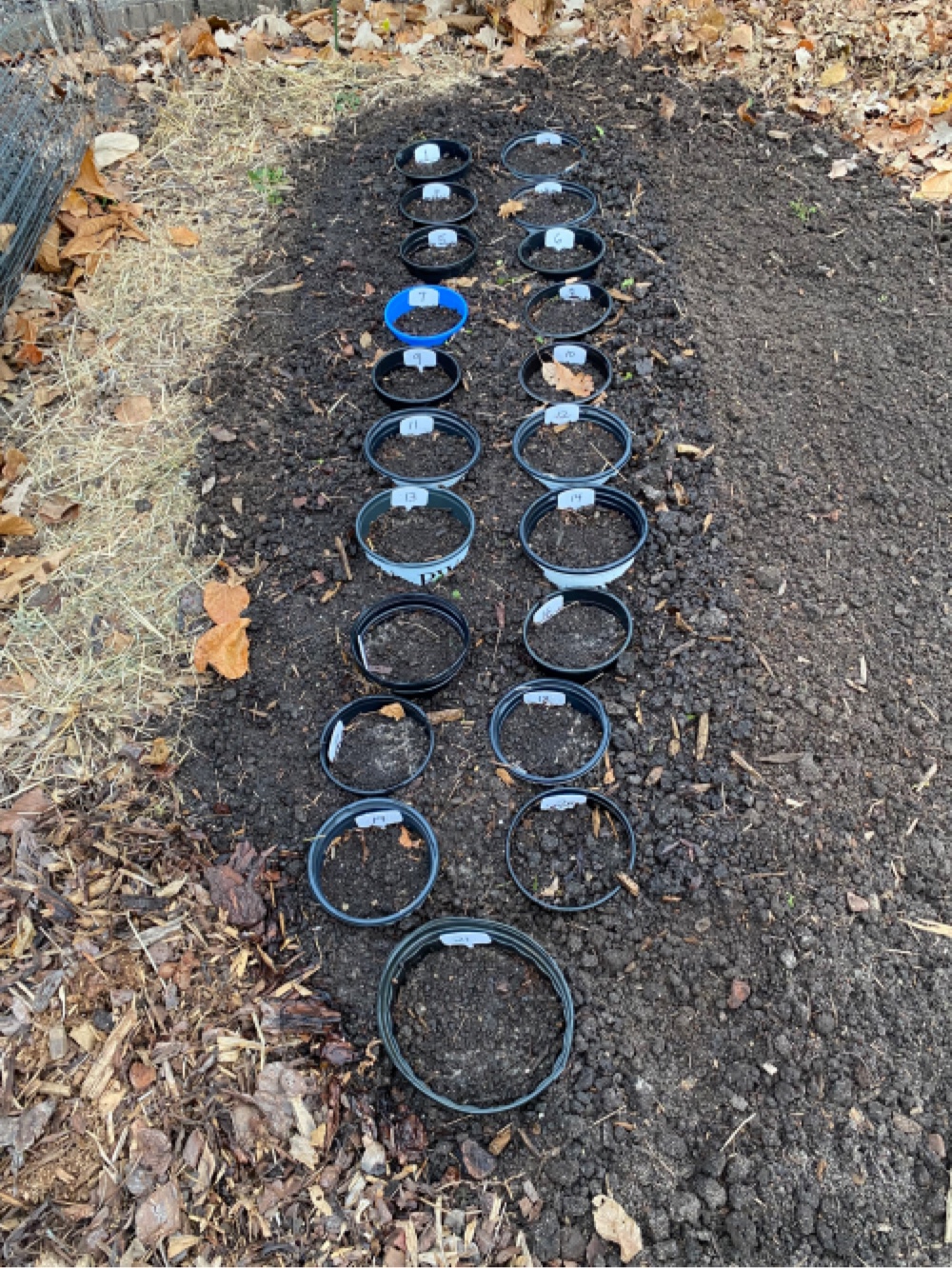 |
|
I planted the Torreya seeds on November 4. I planted one seed in each of 21 one-gallon containers, and then buried the containers in the ground in my yard. Each container has a numbered tag.
As an experiment, I added 1 cup of lime (calcium carbonate) to 2 containers, half a cup to two containers, and a quarter cup to 2 containers. Since the species is native to limestone bluffs, so I thought it would be interesting to see if the additional calcium affects their growth.
I buried two of the seeds 2 inches deep, and all the rest 4 inches deep. I then covered the containers with fencing to keep the squirrels out.
Now I have to wait out the winter — that is, if we get a winter. I can't believe how mild this fall has been. Some trees in my neighborhood are still hanging on to their brilliant leaves.
|
• November 2024/ Joe Facendola / New seed cleaning method for the ~1,250 seeds collected in North Carolina
 |
|
Since 2019, Joe Facendola (of Wilmington NC) has been collecting seeds at two homes in North Carolina: Clinton and Mt. Olive. He then prepares them for shipping and planting by volunteers.
LEFT: Approx. 600 cleaned seeds collected from the pair of torreya trees in Mt. Olive. They are sitting in a half-inch mesh screen tray. Remnants of the sarcotesta that were squished off, then rinsed with the hose, are below the screen frame.
METHOD: I first soak the collected whole seeds for 2 or 3 days, changing the water daily. Next I dump them out onto a .5" wire screen. I use a gloved hand to squish them around to remove the softened sarcotesta, and blast them with a jet of water from the hose while shaking the screen. They get dumped back into the bucket and rinsed with a jet of water from the hose again before getting one final rinse on the screen.
|
• November 2024/ Joe Facendola and Connie Barlow/ New growth-form experiment launched in coastal North Carolina
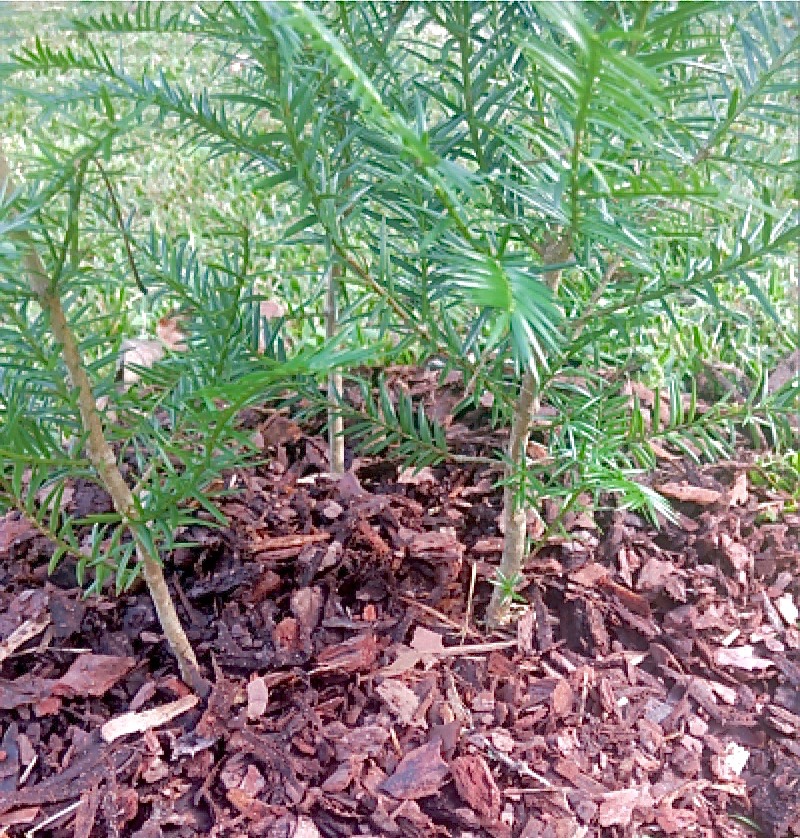 |
|
JOE FACENDOLA began planting torreya seedlings in his backyard in Castle Hayne (a suburb of Wilmington) in 2023.
His plants receive a lot of sunlight in his backyard, and they have no competition because they are planted on mowed lawn.
Joe is the first Torreya Guardian to experiment with planting clumps of seedlings in sets of 3, each about 6 inches from the others (photo). Will this planting prove feasible for all three to grow together into a tree form? Will such clumping reduce herbivore damage to the leaders and inner branches? And once they become old enough to attract buck deer antler rubbing, will this form also reduce such damage?
In November 2024, Joe planted an additional two clumps like this (photo left) in his mowed backyard, each about 10 feet away from the others. There are a total of 9 plants now, in 3 clumps.
|
• November 2024/ Mike Heim/ Status of 16 young torreyas in northern WISCONSIN
 |
|
I just finished mapping the 16 T. taxifolia in the woodland exclosure.
One is a rooted-cutting planted last year. The 15 young seedlings emerged from seeds harvested in Clinton and Mt. Olive NC in November 2020. Those seeds were direct planted in Wisconsin that same month, beneath a deciduous canopy and within a fenced deer exclosure.
Just 3 of total had shown up as seedlings during 2023. The other 12 showed above-ground growth for the first time this year.
These findings thus document that, in northern Wisconsin, wild-planted seeds take more than the usual 2 summers to appear as seedlings. Some required 3 summers; most required 4.
LEFT: Freezing nights have arrived in Wisconsin.
• Mike's torreya page.
|
• November 2024/ Fred Bess/ Parma, OHIO, photos of seed harvest from 3 female stems
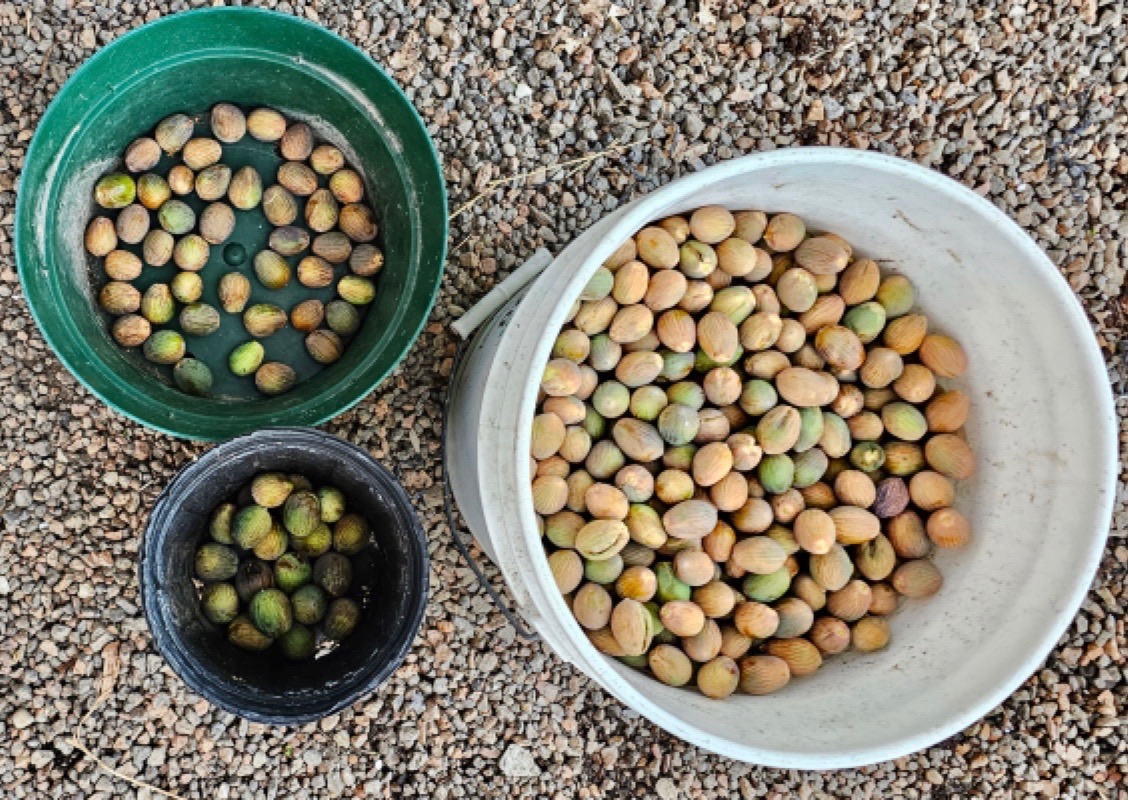 |
|
Fred reports, "I harvested this year's seeds on November 2, after noticing that they were beginning to fall."
Seed production was reduced from the amount in 2023, but still quite high.
ESTIMATED COUNT: "Around 40 from the twin tree female, 30 from the cutting-grown female, and my big girl likely has around 800."
• Fred's torreya page.
|
• November 2024 / Connie Barlow / HISTORIC GROVES map and page updated for SITES OF NEW SEED PRODUCTION by Torreya Guardians
Exactly 20 years after the late Paul S. Martin and I published in Wild Earth magazine our advocacy paper, "Bring Torreya taxifolia North — Now", two more sites of Torreya Guardians northward plantings have been documented as producing seeds.
 |
|
The TWO NEW SITES are shown on this segment of map as B4 and B5 — with PINK signifying "Mature Trees Producing Seeds". (WHITE are sites fully "naturalized" because they are old enough to have offspring establishing in their surrounds. YELLOW are old and thus mature trees, but with no documented seed production.)
That new plantings in North Carolina by Torreya Guardians are now producing seeds is not surprising. Notice the 5 WHITE sites in North Carolina that were planted and producing seeds before our group got started.
The B1 pink site at CLEVELAND OHIO (planted by Torreya Guardian Fred Bess) is still our banner site. Seed production there began in 2018. Even that far north is proven suitable for assisted migration of our country's most famous "left behind" glacial relict: Florida Torreya.
Visit our Historic Groves page, and see the new seed photos taken by Torreya Guardian Joseph Guite at B4 (Cowee Valley, NC) and at B5 (Tessentee Bottomlands Preserve).
|
• October 2024 / Joseph Guite / Visited 3 TORREYA GUARDIANS PLANTINGS in western NC and documented SEED PRODUCTION at two of them.
|
| 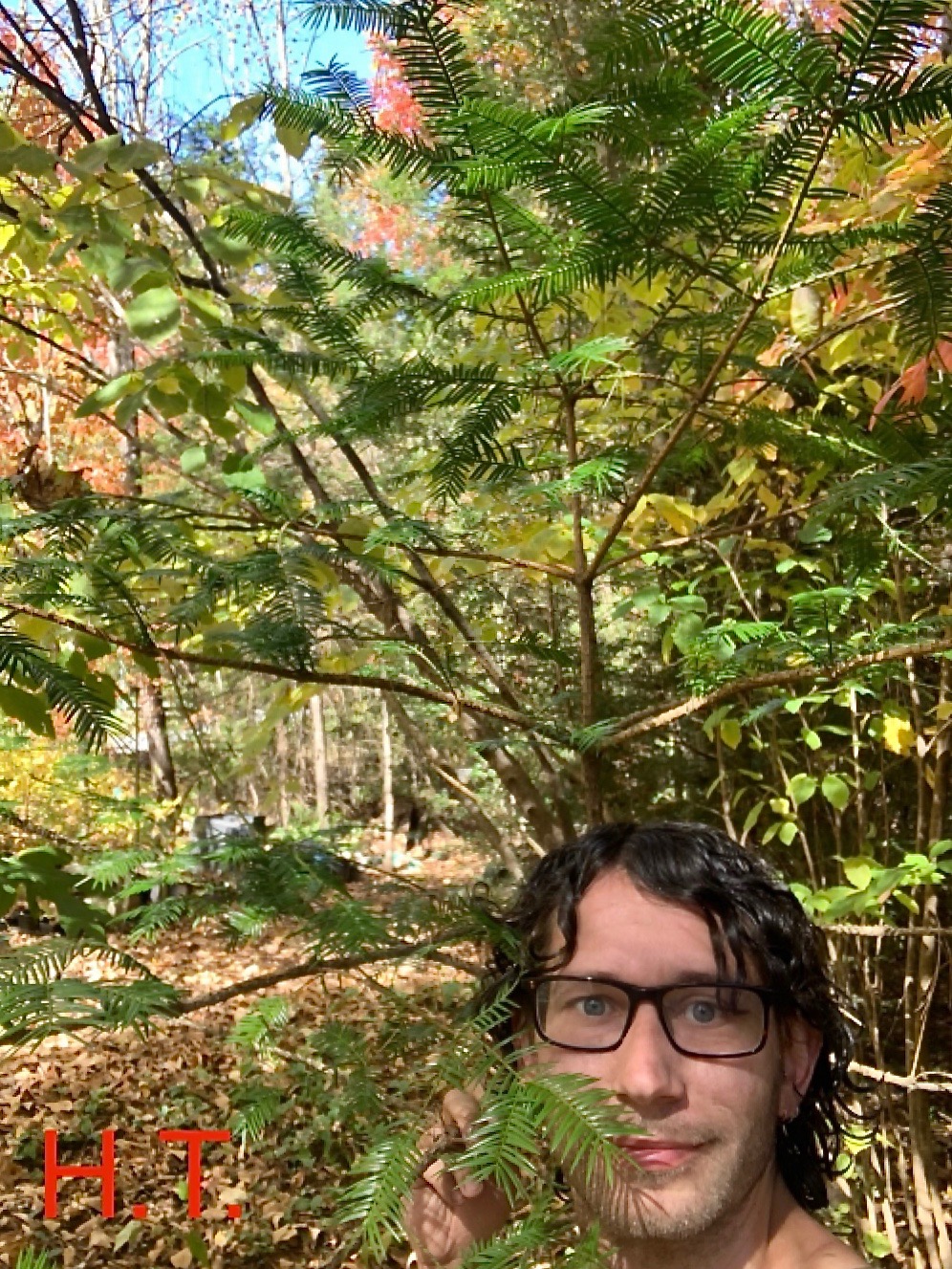 |
|
JOSEPH GUITE is one or our newest Torreya Guardians.
He happened to be visiting in North Carolina when Hurricane Helene hit. While using his own truck for transporting relief supplies to the flood victims, he took a quick side visit to our 2008 plantings at LAKE JUNALUSKA. Four torreyas are still alive there, with the tallest being the Thoreau tree (photo at left). See more of his Lake Junaluska torreya photos.
On his way to wintering in Florida he visited two more plantings in North Carolina by Torreya Guardians.
PHOTO BELOW LEFT: Our Cowee Valley planter, Lamar Marshall, had already reported first seeds in 2023. Joseph photo-documented the 5 full-sun trees there, with seeds on 3 of them.
PHOTO BELOW: Joseph made the first documentation of seed production on some of the 30 torreyas planted in 2012 at the Tessentee Preserve.
See all his photos of torreyas at Cowee Valley and
Tessentee Preserve.
|
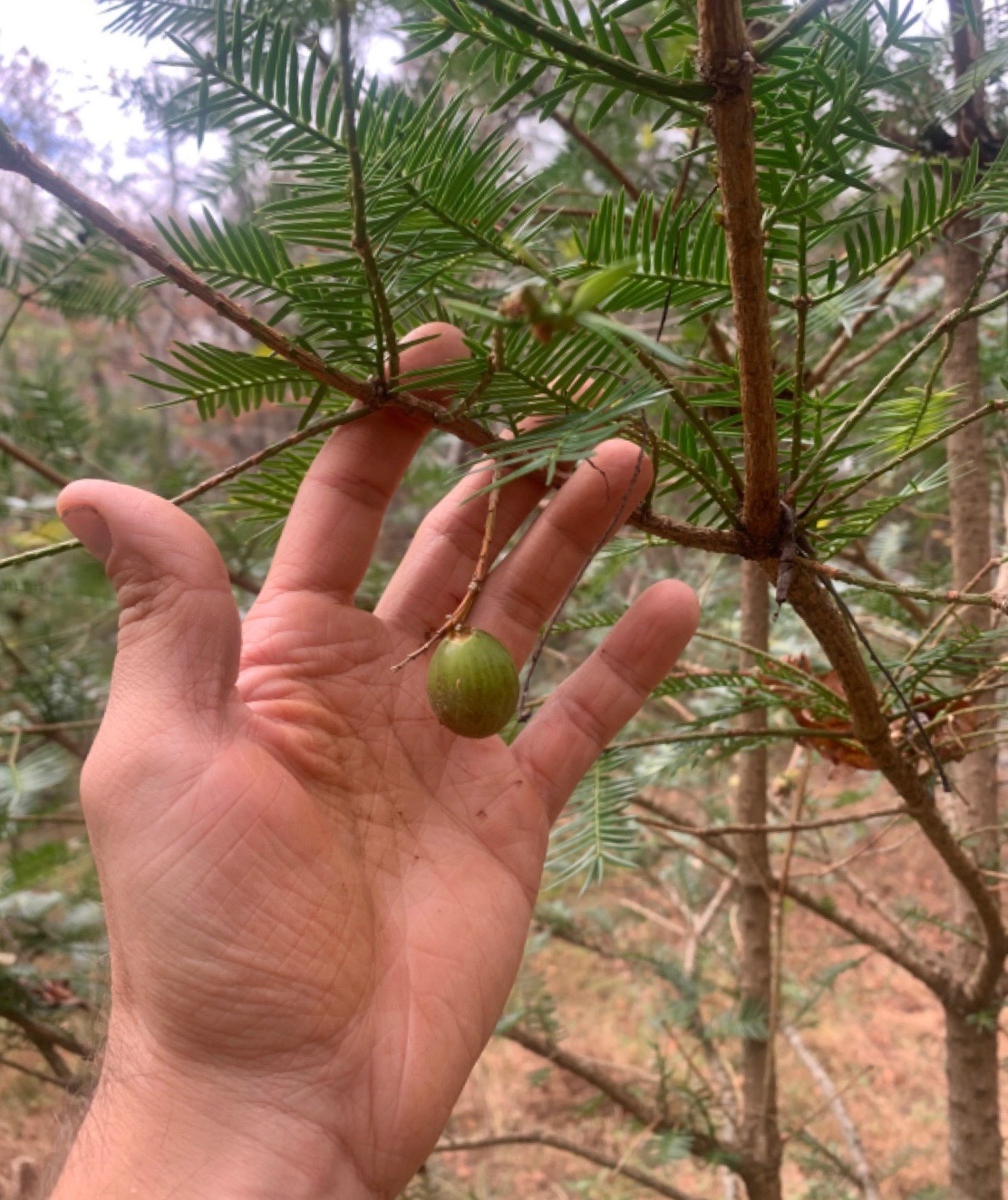

• October 2024 / Russell Regnery / Documentation of Florida Torreya at Highlands Biological Station NC
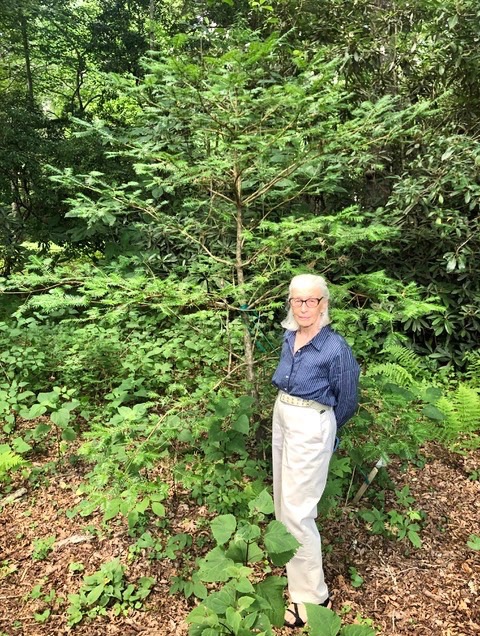 |
| |
Highlands Biological Station, in Highlands NC, is associated with Western Carolina University.
Specimens of Florida torreya had apparently already been planted onsite before Torreya Guardians in 2015 served as a conduit for donated seeds (of wild genetics) from one of the two official ex situ orchards of the species in northeastern Georgia.
Russell Regnery (Torreya planter near Franklin NC) had partnered with Jack Johnston (Torreya planter in NE Georgia) in 2022 as volunteers to safely transplant existing scattered specimens at the station into one area, where cross pollination could eventually occur.
Russ returned in 2024 to check on the health of transplanted specimens and to photograph the tallest among them (LEFT). There is no documentation yet of seed production.
|
• September 2024 / Don Thomas / Photos of California torreya seedlings in shade v. full light
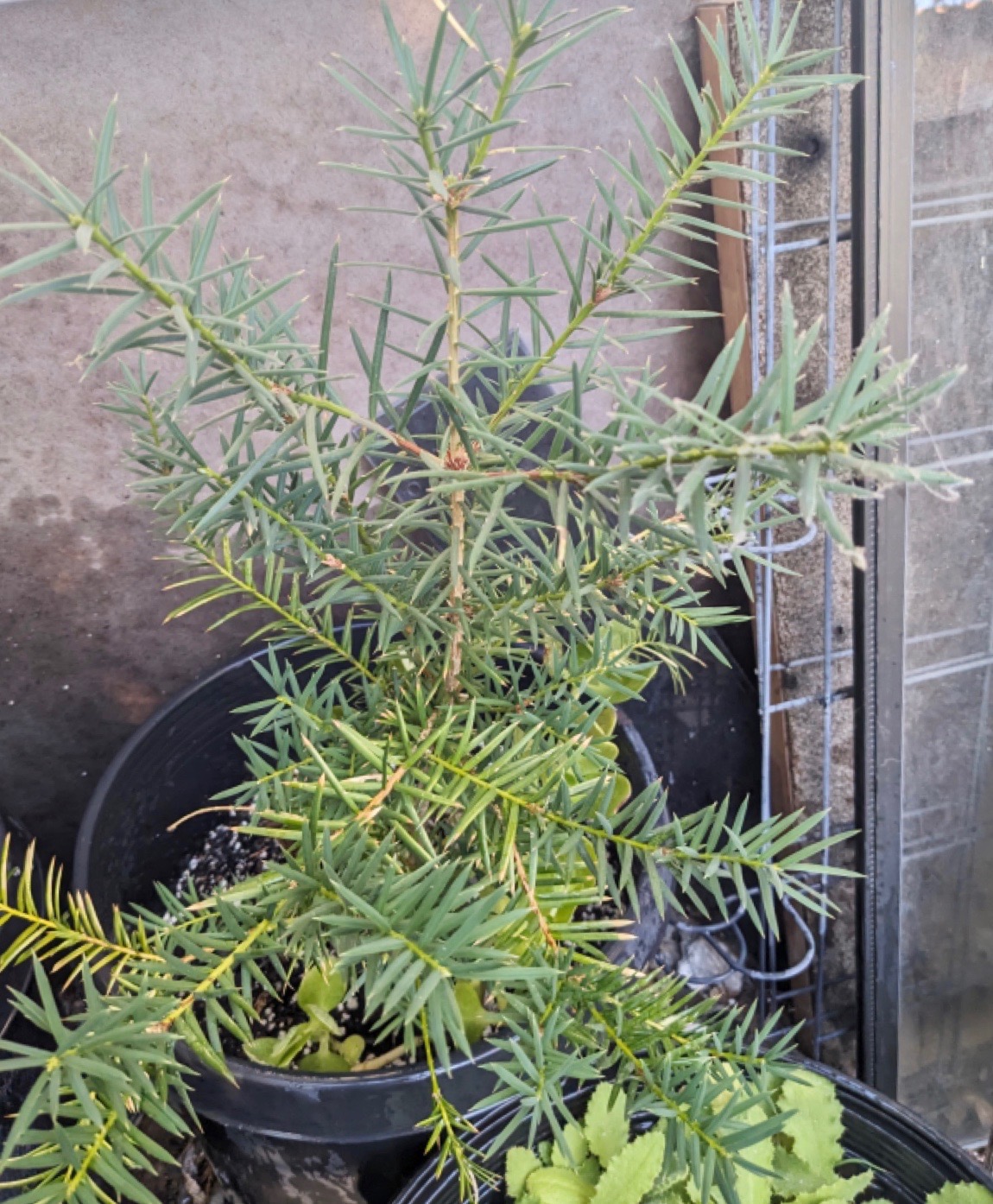 |
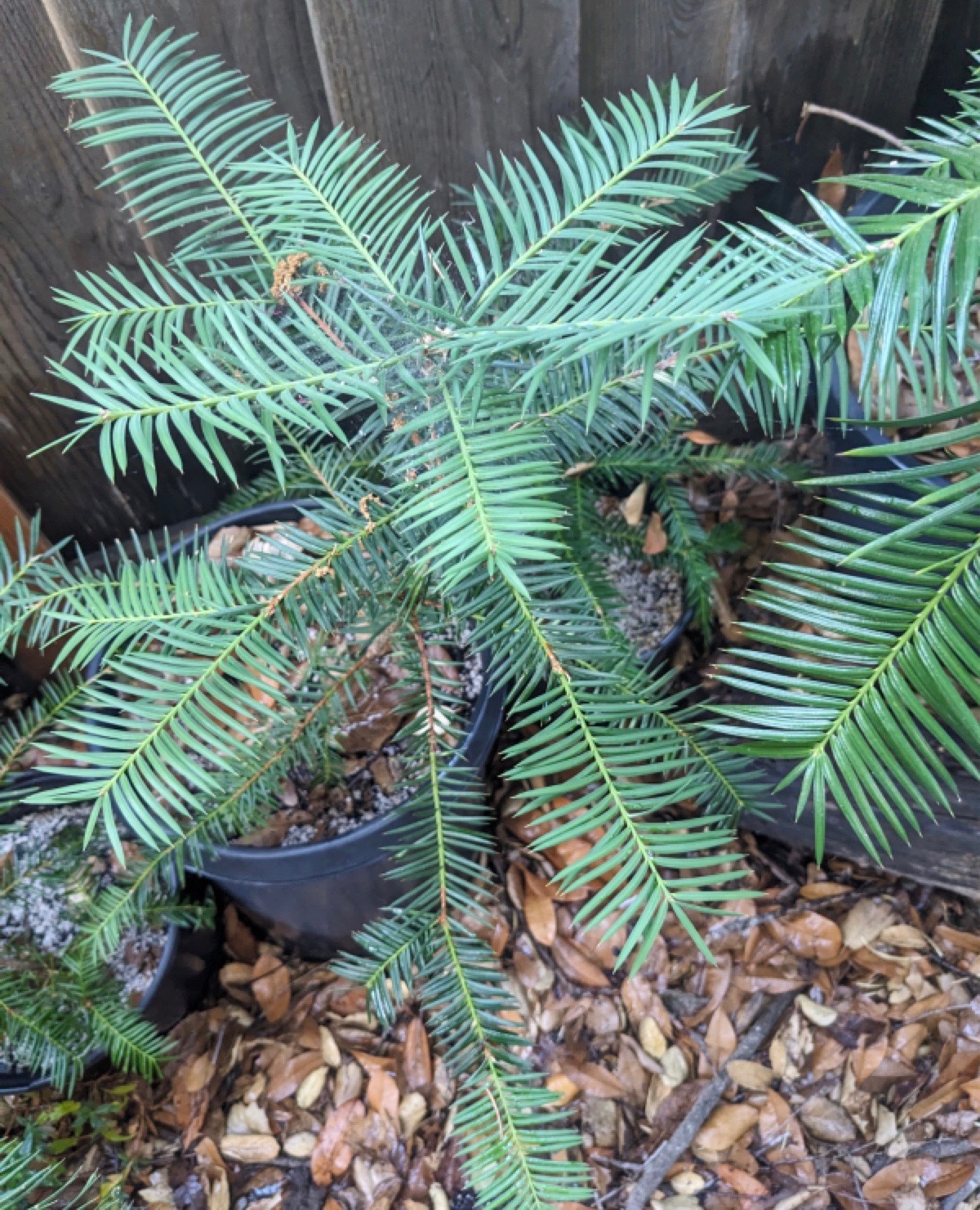 |
|
Although this website began with a focus solely on FLORIDA TORREYA, distinct pages have been added pertaining to CALIFORNIA TORREYA.
Don Thomas is the founder of TorreyaGuardiansWest, for which the main page is here: here. He sent us these two photos of an experiment he is doing at his home in San Jose, California.
The differences are striking in LEAF ADAPTATIONS in full sunlight (and thus also heat) v. the usual flat leaf orientation of subcanopy shade. What is also striking is the color difference. |
• September 2024 / Connie Barlow / INDIANA now has a photo page on our website
 |
|
SITE DESCRIPTION: Forest edge, Indianapolis
TIMING: After 2 winter stratifications (of seeds harvested November 2021 at Clinton and Mt. Olive North Carolina) followed by no germinations, the seeds were assumed to be duds and were tossed into the duff at the owner's forest edge summer of 2023.
Surprise! September 2, 2024 this photo was taken by a volunteer planter near Indianapolis.
Clearly, this is first-year growth of vibrant young seedlings in a sunny location.
This photo is thus another confirmation that it can sometimes take 3 winter stratifications for seeds to germinate.
Note: During the the 2024 growing season, we added 3 new states as page links from the Torreya Guardians homepage: Illinois, Missouri, and Indiana.
|
• August 2024 / Connie Barlow / MISSOURI now has a photo page on our website
This website has state-by-state pages that can be accessed via our homepage. We have distributed seeds to some states in eastern USA that are not listed there, however. This is because, as webmaster, I only create a unique webpage for a state if someone provides a photograph of their torreya planting. However, I just added a photo and text for a MISSOURI page — because:
 |
|
MISSOURI BOTANICAL GARDEN has online very detailed and complete tabular documentation of all Torreya taxifolia accessions. Data include for each specimen current status (alive or dead), provenance, and garden location.
PHOTO: The earliest acquistion that is STILL ALIVE onsite came from one of the two plants received in 1992 from the Biltmore Estate in NC.
Much later, in 2018, they received from Atlanta Botanical Garden a total of 43 "plants" plus 6 "seedlings." All seedlings (2018-0053) were put into the "Greenhouse outdoors" and are listed as dead. Of the 43 "plants" from ABG in 2018, 26 were put into the "Greenhouse indoors" and all are now listed as "Transferred." Of the remaining 17 plants from ABG listed in various places onsite, 5 are listed as ALIVE.
Of course, the only possible plant at a reproductive age would be the 1992 Biltmore acquisition, as in the PHOTO here. None of the other specimens have photos linked.
Go to our MISSOURI page to access more information about torreya propagation at the Missouri Botanical Garden. Notably, this institution suggests that this species is "probably hardy to Zone 5" — which is significantly north of Florida! |
• August 2024 / Mike Heim and Court Lews / Status reports from Wisconsin and Tennessee
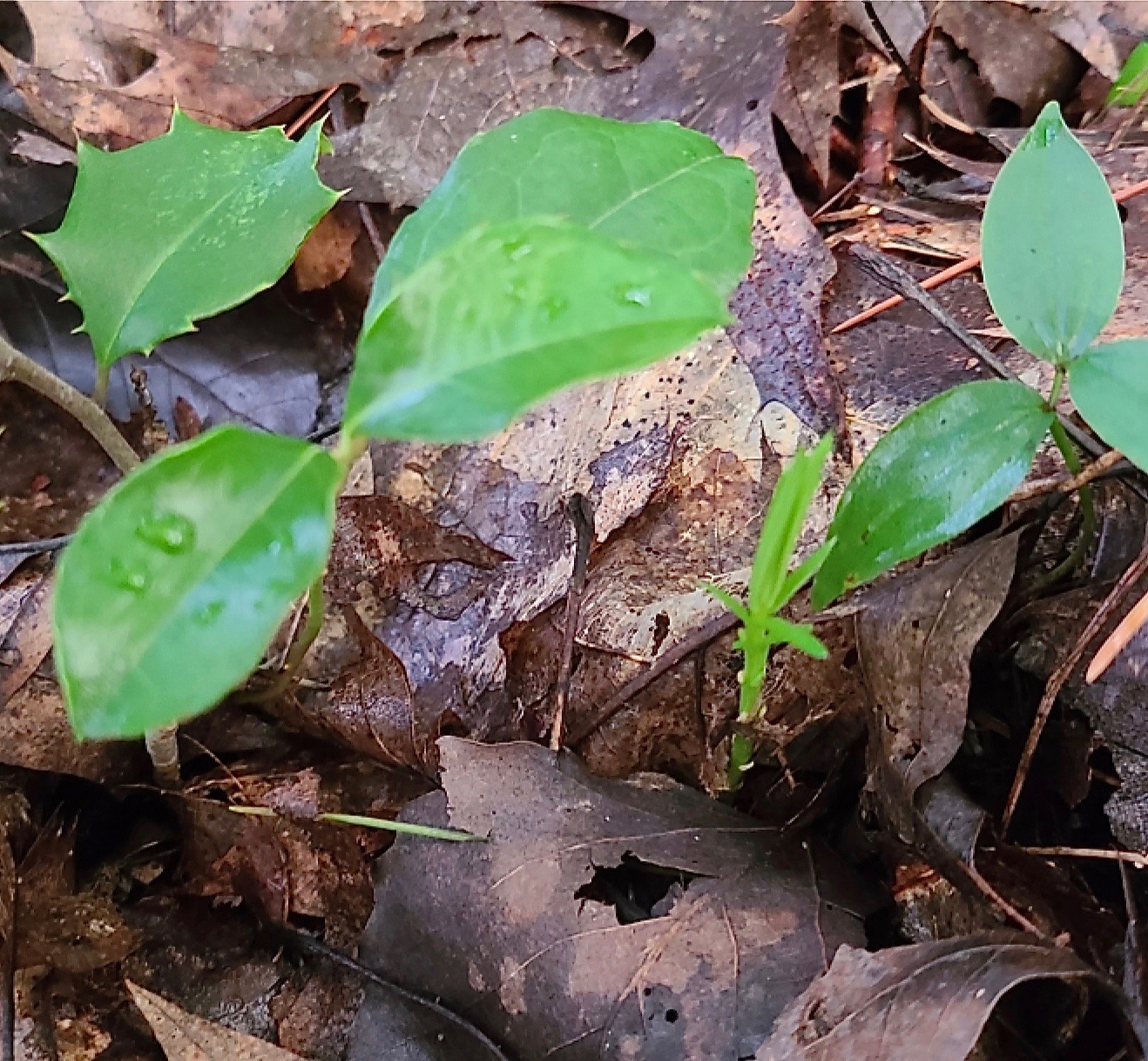 |
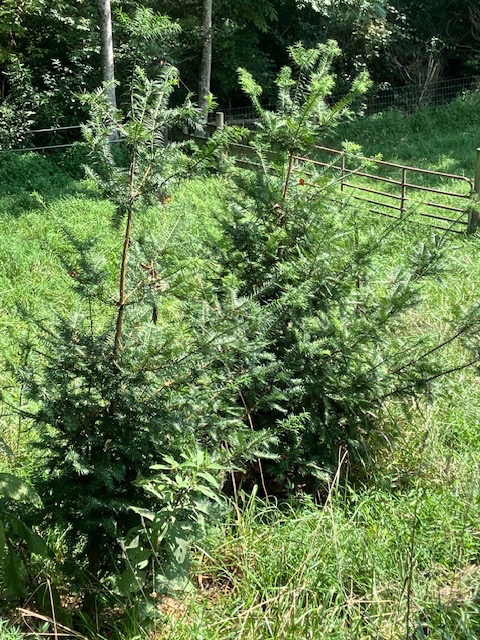 |
|
FAR LEFT: Photo by Mike Heim of Hayward WI, of his third newly emerged seedling this summer.
All three hail from seeds harvested in Clinton and Mt. Olive NC in November 2020 and direct planted in Wisconsin that month, beneath a deciduous canopy and within a fenced deer exclosure.
This photo thus documents that some seeds may take 4 winter stratifications (rather than the usual 2 or 3) before any growth shows above ground.
|
ABOVE MID: Photo taken by Court Lewis of Unicoi TN. 2015 was the final year that superabundant seeds from the ex-situ torreya orchard at Blairsville in northern Georgia were donated to Torreya Guardians. Hence, they are wild genetics, and thus extraordinarily important for eventual seed production. The tallest is 9-feet and the photo shows how full-sun sites (requiring mowing) offer fastest growth.
• August 2024 / Connie Barlow / An Update on TorreyaGuardiansWEST
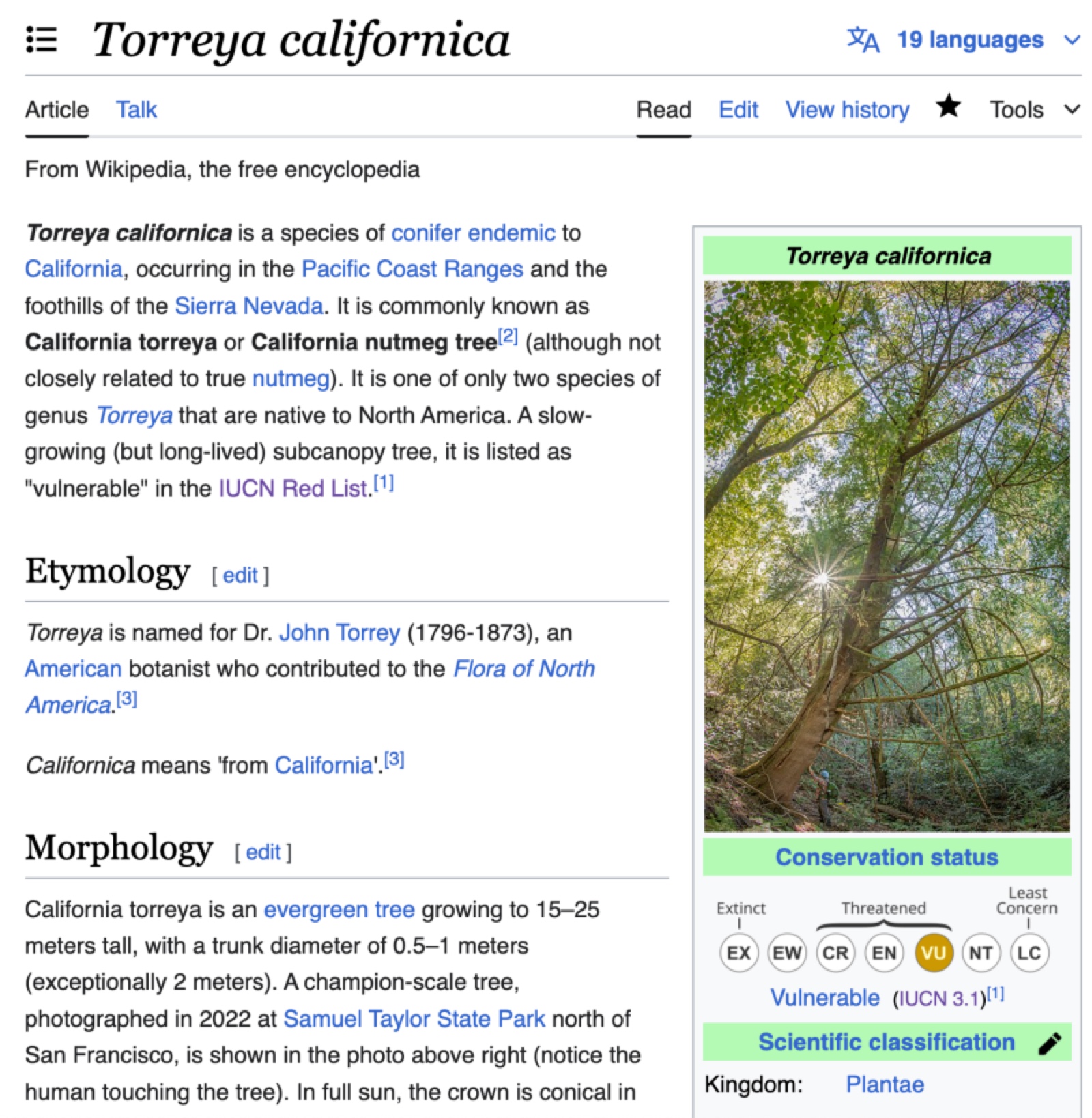 |
|
In 2022, TorreyaGuardiansWEST was founded by Don Thomas. As shown in the WIKIPEDIA screen capture here, California torreya is not a listed endangered species. It is therefore a lot easier for them to obtain wild genetics seeds for their own assisted migration of this endemic California tree northward (as far as British Columbia). Learn more on the California torreya page on this website.
This past week has been a flush of information-sharing emails, focusing on the ablity of the Torreya genus (in California and Asia) to attain great age and size — but always in the mountains and usually on steep slopes.
Torreya is more closely related to COAST REDWOOD than it is to any pine. And in our discussion this month (including one of the lead academics in redwood research in California) we learned of more similarities between the two.
Another of the participants was the person who found and photographed the champion-size Calif torreya that I then inserted into the official wikipedia page of that species.
|
• August 2024 / Jim Thomson and Connie Barlow / Update on torreya planting in Cullowhee, NC
CONNIE WRITES: In preparation for submitting a status report last month to USF&WS on our citizen plantings (see directly below), I queried our planters in order to update those who had sent in enough photos and reports in past years for me to have created site-specific pages of their projects. Sadly, one planter (Nelson Stover in Greensboro NC had died), and one other in NC (older than me!) who had reported a year ago of first seed production has not responded to two of us who tried.
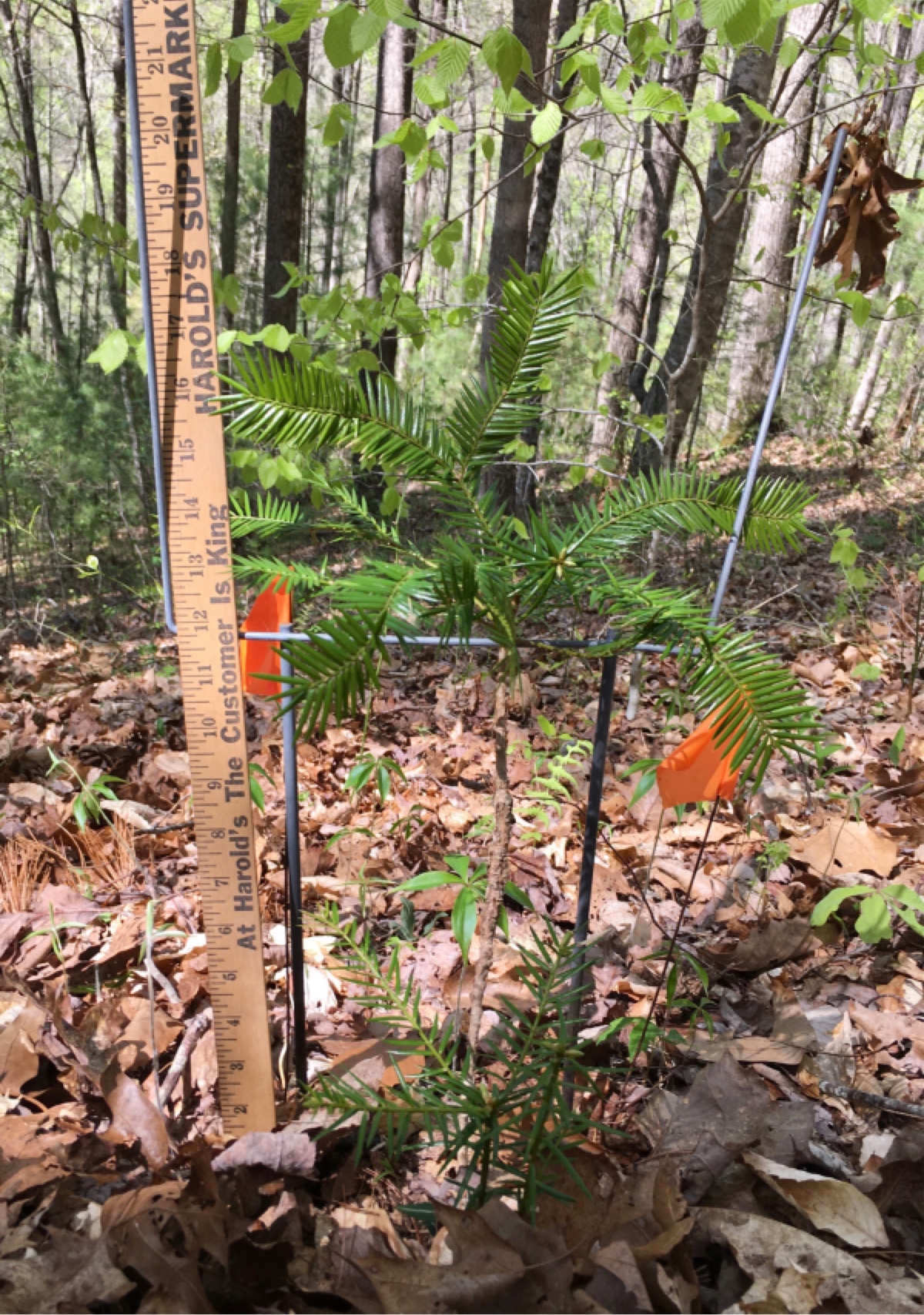 |
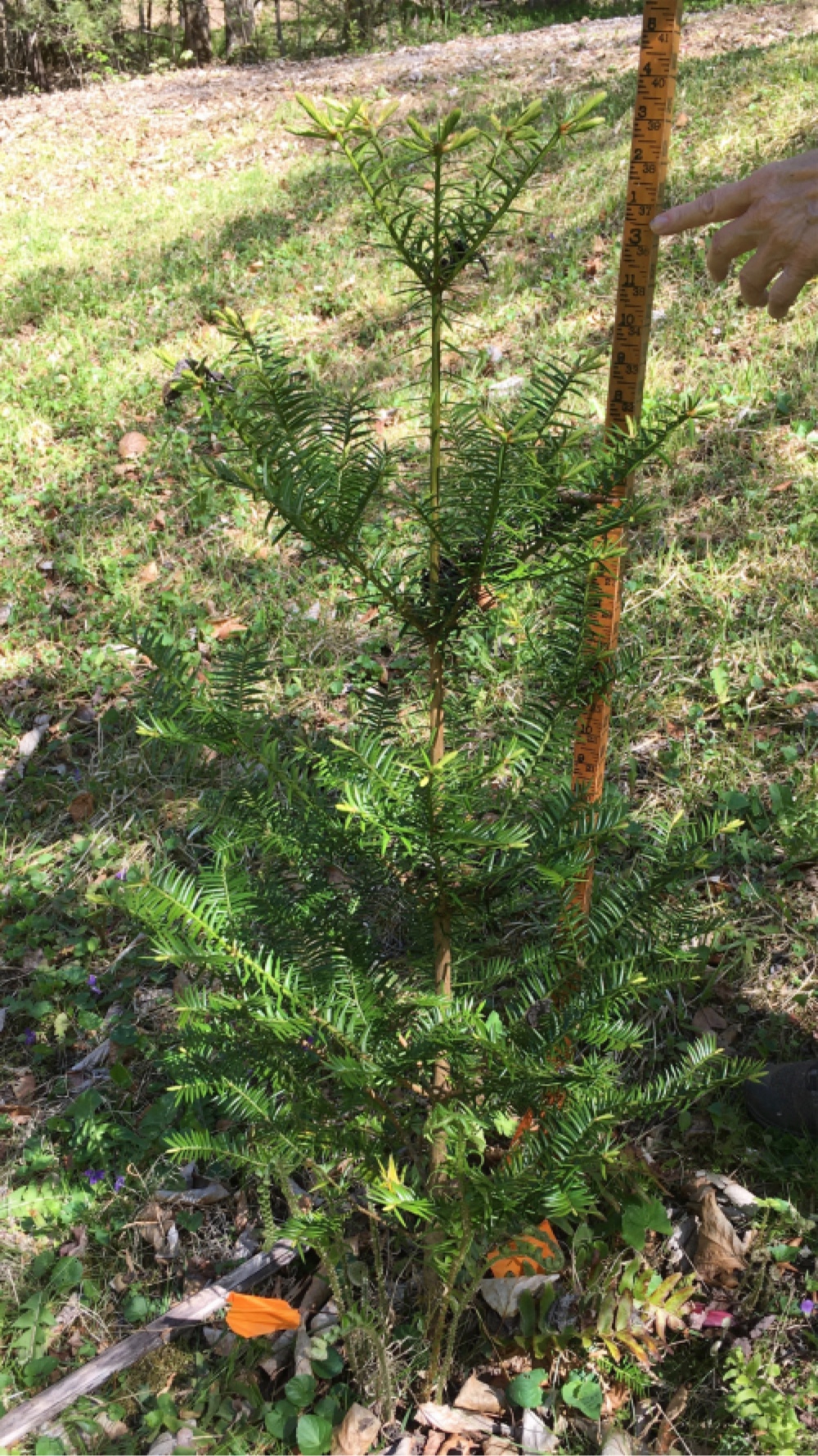 |
|
As a citizen group, our own plantings are almost always |